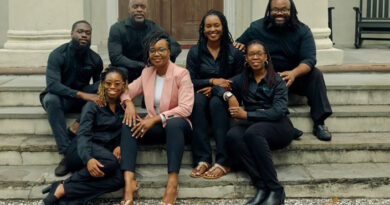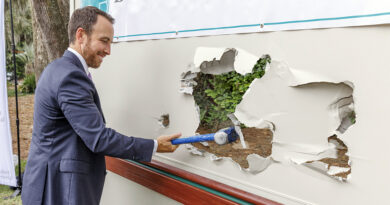Telling America’s Untold Story— The Santa Elena History Center
Story By: Carol Lauvray | Photography By: Paul Nurnberg
The saga of Santa Elena is a centuries-old story still unfolding today—a story largely unknown to the public before the Santa Elena History Center opened its doors in 2016. Operated by the Santa Elena Foundation, the History Center’s exhibits showcase 16th century exploration and settlements, focusing on the Spanish town of Santa Elena located on Parris Island, South Carolina from 1566 – 1587. “The Foundation’s vision is to expand the knowledge of Santa Elena and other 16th century European settlements in the area of the Port Royal Sound and make a sustained, positive contribution to the local economy,” says Dr. Andrew J. Beall, Chairman of the Santa Elena Foundation. “We’re achieving that vision through ongoing archaeological research of the Santa Elena site and the History Center’s exhibits and programs, designed to educate visitors about Santa Elena and its historical significance.”
Europeans discovered the Beaufort area and Port Royal Sound more than 450 years ago—before St. Augustine, Jamestown and Plymouth. In May 1562, the French explorer Jean Ribaut landed on what is now Parris Island and built a fort called Charlesfort. Without adequate food, the French were forced to abandon Charlesfort less than a year later. During the mid-16th century, Spain was competing with France for control of North America and colonizing points along the Southeastern coast from the Caribbean to the Carolinas. In 1566, Spanish naval officer Pedro Menendez de Aviles founded Santa Elena, the first colonial capital in Spanish La Florida, on the same site as Charlesfort.
Uncovering History
Archaeologists began unearthing Santa Elena’s secrets at the site on Parris Island in 1979. Chester DePratter, Ph.D., of the South Carolina Institute of Archaeology and Anthropology (also an Advisory Board Member of the Santa Elena Foundation), has conducted extensive excavations at the site over the years. This work led to his discovery of the location of Charlesfort, established on Parris Island in 1562, before the founding of Santa Elena there in 1566 by the Spanish.
Since archaeologists began their work at Santa Elena, they have uncovered hundreds of French and Spanish artifacts and discovered an intact well and a pottery kiln buried at the site. Just last summer, the location of one of Santa Elena’s Spanish forts was identified—Fort San Marcos I, built on Santa Elena in 1577. Including France’s Charlesfort, a total of six forts were built on the site during the 16th century. Five of the forts were Spanish and are described in documents and a map preserved in the Archive of the Indies in Seville, Spain. For nearly 20 years, the archaeological search for Fort San Marcos I was unsuccessful, so Dr. DePratter enlisted the aid of his friend and colleague, Dr. Victor Thompson of the University of Georgia, to try a new approach. In 2016, the two archaeologists were finally able to determine the location of Fort San Marcos I, using ground-penetrating radar and other electronic devices to look beneath the ground’s surface.
Telling Santa Elena’s Story
After that discovery, a new exhibit “Building Fort San Marcos,” featuring a 3-dimensional model of the fort, was unveiled at the Santa Elena History Center this spring. Using a drawing of Fort San Marcos I and a first-hand narrative describing the fort (both from the Archive of the Indies), Dr. DePratter created a set of detailed scale drawings of the fort. Model maker Ruben Alex Coplo used those drawings to construct the 3-dimensional model, which is the centerpiece of the newest exhibit at the History Center. Andy Beall adds, “When additional funding is available, we’ll be able to take the new 3-D scale model of Fort San Marcos to the next level by developing a virtual reality experience for visitors, so they can ‘walk through’ the reconstructed 440-year-old fort on Santa Elena. The video will allow visitors to tour the fort virtually while listening to the actual words of the Spanish inspector Alvaro Flores, who documented the two-story fort’s rooms and contents, including 80 beds for soldiers and 10 cannons, in his 1578 written report.” Dr. Beall emphasizes that Santa Elena is an emerging story and as ongoing archaeological research reveals more information, the History Center’s exhibits and programs will continually evolve and be enhanced.
Megan Meyer, Executive Director of the Santa Elena Foundation and a Beaufort native, says Phase II of the History Center’s main exhibit “Santa Elena: America’s Untold Story” is currently in the planning stage. The second phase of the main exhibit will add the story of Captain Juan Pardo, who led 250 soldiers inland to the Appalachian Mountains; provide more information about the archaeological discoveries of the well, kiln and Fort San Marcos I; and add replicas of weaponry, clothing and other items to the exhibit to help bring the story of Santa Elena to life.
“In addition to Phase II of the main exhibit, as funding becomes available other projects will include: creating living history interpretations with period costumes and props; building an archaeological laboratory and research facility at the Santa Elena History Center; and establishing a children’s interactive area at the Center,” says Ms. Meyer. Another project on the Foundation’s wish list is to search for the French ship Le Prince, known to have wrecked in 1577 in Port Royal Sound. “Maritime Historian and Nautical Archaeologist Jim Spirek will lead that research when funding is available,” she says.
Collaboration and Partnership—Keys to Realizing the Vision
Andy Beall emphasizes the importance of collaboration and partnerships in realizing the Santa Elena Foundation’s mission and vision. The Foundation works with noted archaeologists and scholars, as well as with community, local government, and business leaders, and many of them serve on its board of directors or as advisory board members. Count Alvaro Armada Barcaiztegui of Spain, a direct descendent of Pedro Menendez de Aviles, also serves on the Foundation’s board.
“We’re also indebted to the dozens of volunteers in our community who donate thousands of hours of their time annually to greet visitors and keep the History Center open,” says Dr. Beall.
In addition, the Santa Elena Foundation partners with other local educational, cultural and history organizations. Examples include: the Heritage Library of Hilton Head Island’s new branch for ancestry research, located in the Santa Elena History Center; Beaufort History Museum’s and the Verdier House’s partnership with the History Center on a three-museum pass for visitors; a new station at the History Center sponsored by Kinghorn Insurance that helps visitors of all ages learn about Santa Elena through video games developed by USCB students; and the Beaufort Art Association’s creation of beautiful murals depicting the founding of Santa Elena in the Center’s first-floor hallway.
And Ms. Meyer says another partnership is in the works with the Carolina Marsh Tacky Association to hold a family-oriented Lowcountry Fair in November this year. The event will feature races with Marsh Tacky horses (the horses Spaniards brought here) and will celebrate Santa Elena with living history re-enactors, performances, music and food.
The Santa Elena History Center opened at 1501 Bay Street just over a year ago, but has already made great strides telling America’s Untold Story—the exciting story of Santa Elena—to thousands of visitors. Plan to visit soon to learn the most recent findings about how European settlement in America began right here in Beaufort!
For hours and information, visit: WWW.SANTA-ELENA.ORG




